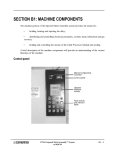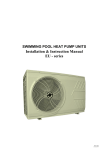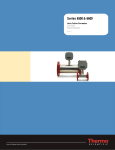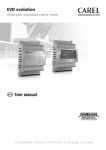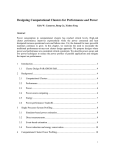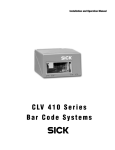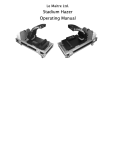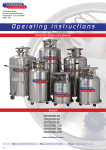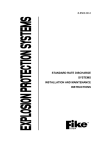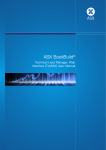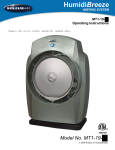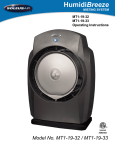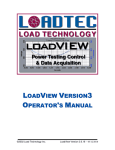Download Series 5100 and 5400 - User Manual
Transcript
Series 5000 & 5400 Insertion Turbine Flowmeters User Guide P/N 057-0352-004 Revision A Part of Thermo Fisher Scientific Series 5000 & 5400 Insertion Turbine Flowmeters User Guide P/N 057-0352-004 Revision A ©2007 Thermo Fisher Scientific Inc. All rights reserved. All trademarks are the property of Thermo Fisher Scientific Inc. and its subsidiaries. Thermo Fisher Scientific (Thermo Fisher) makes every effort to ensure the accuracy and completeness of this manual. However, we cannot be responsible for errors, omissions, or any loss of data as the result of errors or omissions. Thermo Fisher reserves the right to make changes to the manual or improvements to the product at any time without notice. The material in this manual is proprietary and cannot be reproduced in any form without expressed written consent from Thermo Fisher. Thermo Fisher Scientific 1410 Gillingham Lane Sugar Land, TX 77478 USA Phone: 713-272-0404 Fax: 713-272-2272 Web: www.thermofisher.com Thermo Fisher Scientific 14 Gormley Industrial Avenue Gormley, Ontario L0H 1G0 Canada Phone: 905-888-8808 Fax: 905-888-8828 This page intentionally left blank. Series 5000 & 5400 INSERTION TURBINE FLOWMETERS SERIES 5000 & 5400 HANDBOOK Rev. A Issue Information Issue Description 0 CN 8653 A Per ERO 5982 Thermo Fisher Scientific Series 5000 & 5400 This page is blank Thermo Fisher Scientific Series 5000 & 5400 SAFETY NOTICE Read this manual before working with the product. For personal and system safety, and optimum product performance, make sure you thoroughly understand the contents before installing, using or maintaining this product. YOU ARE RESPONSIBLE FOR YOUR OWN SAFETY AND THAT OF YOUR COLLEAGUES. Be aware of the weight of meters and the component parts as meters increase in size. Safety boots/shoes and eye protection must be worn whenever bench work is undertaken. Use lifting gear as appropriate, or at certain assembly or disassembly stages, enlist extra help. Note: some items have sharp edges and corners. For equipment service, please contact Thermo Fisher Scientific. Thermo Scientific products satisfy all obligations arising from European Union legislation to harmonise product standards. Thermo Fisher Scientific Series 5000 & 5400 This page is blank Thermo Fisher Scientific Series 5000 & 5400 Insertion Turbine Flowmeters SECTION 1 INTRODUCTION SECTION 2 SAFETY INDEX Page No. Purpose Applicability Other Sources of Information 1-1 1-2 1-2 Control of Substances Hazardous to Health Pressure Hazards Electrical Safety Meter Protection Handling Pick-ups Installed Protection 2-1 2-1 2-1 2-1 2-1 2-2 2-2 SECTION 3 GENERAL DESCRIPTION Principles of Operation Series 5000 Turbine Meters Series 5400 Turbine Meters 3-1 3-1 3-3 Flow Straightening Tanks Air Entrainment Filtration Liquid Meters with Sleeve Bearing Liquid and Gas Meters with Ballrace Bearing Installation Series 5000 Series 5400 4-1 4-1 4-2 4-2 4-2 4-2 4-2 4-4 General Notes 5-1 SECTION 4 INSTALLATION SECTION 5 MAINTENANCE Index Page 1 Thermo Fisher Scientific Series 5000 & 5400 Insertion Turbine Flowmeters INDEX SECTION 6 INSPECTION AND REPAIR Series 5000 Insertion / Turbine Assemblies Selection of a Turbine Head Assembly Removal of Stem / Pick-up Assembly Low Pressure Collet Clamp Models High Pressure Screw Jack Models Replacement of Seals and Scraper Rings Removal / Replacement of Rotor Assembly Series 5400 Removal / Replacement of the Turbine Capsule Stem Seal and Scraper Ring Pick-up Assembly 6-1 6-1 6-2 6-3 6-3 6-4 6-4 6-4 6-5 6-5 6-6 6-6 Direct Volumetric Calibration as a Velocity Measuring Device Computation of Calibration Constants Sample Flow Calculations – Example 1 (Metric) Velocity Check Profile Factor Computation Blockage Factor Application of Profile and Blockage Factors Frequency for Full Scale Output – Analogue Scaling Estimation of Disturbance Effects Sample Flow Calculations – Example 1 (Imperial) Velocity Check Profile Factor Computation Blockage Factor Application of Profile and Blockage Factors Frequency for Full Scale Output – Analogue Scaling Estimation of Disturbance Effects Table 1 Flow Blockage Factors (Liquid) Table 2 Flow Blockage Factors (Gas) Table 3 Average Profile Factors Flow Disturbance Factors 7-1 7-1 7-2 7-3 7-3 7-3 7-3 7-4 7-4 7-4 7-6 7-6 7-6 7-6 7-7 7-7 7-7 SECTION 7 CALIBRATION Index Page 2 Thermo Fisher Scientific Series 5000 & 5400 Insertion Turbine Flowmeters INDEX SECTION 8 TROUBLE SHOOTING Pick-ups Fault Finding Chart 8-1 8-2 SECTION 9 APPENDIX Figure 1 Figure 2 Figure 3 Figure 4 Figure 5 Figure 6a Figure 6b Figure 7a Figure 7b Figure 8 Figure 9 Figure 10 Figure 11 Figure 12 Figure 13 Figure 14 Figure 15 Index Page 3 Series 5000 Model 1 Head Series 5000 Model 2 Head Series 5000 Models 3-4 Head Series 5000 Model 5 Head Series 5000 Models 6-9 Head Series 5000 Low Pressure Available Parts Listing Series 5000 High Pressure Available Parts Listing Series 5400 Assembly Series 5400 Capsule (Liquid) Series 5400 Capsule (Gas) Inter-Connections – IS / A10 Inter-Connections – non IS / A10 Inter-Connections – non IS / SQ2 Inter-Connections – FDC1100 Inter-Connections – A30 Thermo Fisher Scientific Series 5000 & 5400 Insertion Turbine Flowmeters INDEX This page is blank Index Page 4 Thermo Fisher Scientific Series 5000 & 5400 Insertion Turbine Flowmeters INTRODUCTION SECTION 1 Introduction The development of the insertion turbine meter has resulted from the demand for accurate flow measurement in medium and large diameter pipes, especially in cases where ease of installation is essential, and the cost of full-bore meters prohibitive. Typical applications include water service, chemicals, oil and petroleum products. The insertion turbine meter is a flow velocity-measuring device. When used in a pipe of known cross-sectional area its associated electronics may be calibrated to indicate volumetric flow directly in engineering units such as barrels per hour (BPH), litres per minute (LPM), gallons per minute (GPM), etc. The insertion turbine meter may be used in conjunction with batch controllers, BTU computers or conventional flow rate and totalization indicators. Thermo Fisher’s insertion turbine flowmeter consists of a magnetically permeable rotor assembly installed in magnetically impermeable stainless steel housing. The housing is attached to a stainless steel stem in which the magnetic pick-up is located. The pick-up senses the rotation of the rotor and a pulse is produced each time a rotor blade passes through the magnetic field of the pick-up. The speed of the blade rotation, and consequently the output frequency of the pick-up, is dependent upon the rate at which the media is flowing through the meter. There are two limits to this flow range: a lower limit, below which mechanical friction and magnetic drag prevent the rotor from turning at a speed sufficient to generate pulses, and a higher limit beyond which damage and/or accelerated wear will occur. Between these limits, the flowmeter will produce a virtually constant number of pulses for each unit volume of media, regardless of the rate at which the flow occurs. 1.1 Purpose Section 1 Page 1 of 2 This manual has been laid out to give the end user guidance on installation, detailed maintenance procedures, and spare parts availability. Installation is introduced by an explanation of the principles involved in liquid and gas flow metering using insertion turbine flowmeters. All turbine meters require a pickup, to provide a measurable electrical output, and in turn there are electronic accessories that may be connected to the pick-up output to condition or enhance the signal for onward transmission. Thermo Fisher Scientific Series 5000 & 5400 Insertion Turbine Flowmeters Applicability INTRODUCTION The information contained in this manual is applicable to Thermo Fisher’s insertion turbine flowmeters fitted with sleeve or ballrace bearings. The information contained herein is not influenced by the type of process connection with which individual flowmeters are provided, e.g. flanged, threaded etc. The basic designs of the series 5000 and 5400 flowmeter vary. As a result of this, for the purposes of describing maintenance procedures, the meters have been divided into two categories, as follows: Series 5000 Series 5400 Other Sources of Information For specific details of meter types available, operating ranges, special applications, accessories, physical dimensions etc., reference should be made to the current datasheet: Insertion Turbine Flowmeter Series 5000 Insertion Turbine Flowmeter Series 5400 If there are any doubts regarding the proposed use or installation of the meter/s supplied, please contact Thermo Fisher. Technical Notes are available containing detailed performance specifications and application requirements for all types of turbine meter. For insertion meters fitted with sleeve bearings or ballrace bearings the following publication is available: Technical Note 006: Insertion Turbine Flowmeter Application Guide Thermo Fisher offers a full service and calibration facility. Section 1 Page 2 of 2 Thermo Fisher Scientific Series 5000 & 5400 Insertion Turbine Flowmeters SECTION 2 SAFETY Safety – Important Notice Safety Control Of Substances Hazardous To Health Many metering installations involve the measurement of hazardous fluids. Before removal from service it is important to ensure that the COSHH data is available and appropriate protective measures are taken. In addition there may be site specific procedures relating to protective clothing and hazard handling. Ensure that such procedures are adhered to. Pressure Hazards An insertion turbine meter is considered as a pressure accessory by the Pressure Equipment Directive. Care must be exercised to ensure that the line section is isolated, drained and relieved of pressure before the meter is removed. Read warning labels affixed to the instrument before removal. Before installing new equipment check that the instrument service limits are compatible with the line conditions into which the meter is to be placed in service. The customer is responsible for ensuring that all equipment is protected against overpressurisation, including that caused by external fire. Electrical Safety Before starting any work, ensure that the power connections are isolated and precautions are taken to prevent power being restored whilst work is taking place. Particular attention should be paid to installation conditions specified for hazardous areas (below). Such installations forbid the use of tools or equipment which could produce an explosion hazard. Hazardous Area Use Special conditions apply to meters certified for installation in a hazardous area. Details of permissible installation conditions (ambient temperature, maximum surface temperature and gas groups) are provided on the labels affixed. In addition such equipment may only be installed in hazardous areas classified appropriate to the method of protection. Thermo Scientific flowmeters may be certified to EEx(d) for use in Zone I or Zone II areas or certified to EEx (ia) for Zone 0 applications. Meter Protection Handling Section 2 Page 1 of 2 DO NOT subject the meter or the pick-up to excessive shock loading - never use hammers or mallets. Shock loading can shatter tungsten carbide parts in the meter internals. DO NOT allow foreign bodies (dirt or swarf ) to enter the meter bearings. Note: Surface damage to any of the meter’s turbine head parts can affect its performance. Thermo Fisher Scientific Series 5000 & 5400 Insertion Turbine Flowmeters SAFETY DO NOT use airlines or hoses - any pressured source of air/gas or liquid - to check or clean a meter. (It may be ultrasonically cleaned). If a rotor is allowed to over-speed serious bearing damage may occur. Pick-Ups These form part of the meter body and can not be removed while the meter is in service. Installed Protection AVOID sudden shocks e.g. sudden filling of the process line with a liquid. The trapped air will cause rapid acceleration of the turbine and potential over-speeding. ALWAYS introduce a liquid slowly (relate to the meter range and DO NOT exceed its normal maximum flowrate). Marking The Series 5000/5400 range of turbine meters is marked (when specified) for use in hazardous areas as required by the ATEX Directive. Certification is currently held for Group II Category 2 gases. The protection concept is Flameproof, Temperature Class 4 with a maximum ambient temperature of 55°C. The equipment marking includes the following information:- Section 2 Page 2 of 2 ATEX Certificate No BAS02ATEX2150 II 2G EEx d IIB T5 (-20°C ≤ Ta ≤ 55°C) The maximum voltage The maximum power dissipation in mW Thermo Fisher Scientific 1410 Gillingham Lane Sugar Land, TX 77478 USA Tel: 713.272.0404 Fax: 713.272.2272 HEALTH AND SAFETY (COSHH) CLEARANCE FORM Failure to comply with this procedure will result in equipment service delays. This form must be completed for all equipment returned to Thermo Fisher Scientific (Thermo Fisher) – Sugar Land Depot Repair. Depot repair personnel are unable to handle any equipment that has been in contact with a process fluid or hazardous material if it is not accompanied by this correctly completed Health and Safety Clearance Form. All sections of this form must be completed, and the form must arrive at Thermo Fisher prior to the arrival of the equipment. A copy of this form must also accompany the equipment. Prior to returning any equipment for service, authorization must be obtained from customer service. A Return Material Authorization (RMA) number will be issued and must be entered in Section 1 of this form. Section 1: Reference Details Section 4: Declaration RMA #: Must be authorized ONLY if non-toxic or nonhazardous substances apply. Equipment type: Serial #: I hereby confirm that the equipment specified above has not come into contact with any toxic or hazardous substances. Section 2: Process Fluid Information Signed: All substances in contact with the equipment must be declared. Name: Position: For/on behalf of: Chemical names (list all): Date: Precautions to be taken when handling these substances (list all): Must be authorized if toxic or hazardous substances apply. Action to be taken in the event of human contact or spillage: I hereby confirm that the only toxic or hazardous substances that the equipment specified has been in contact with are named in Section 2, that the information given is correct, and that the following actions have been taken: Additional information you consider relevant: 1. The equipment has been drained and flushed. 2. The inlet/outlet ports have been sealed, and the equipment has been securely packed and labeled. 3. The carrier has been informed of the hazardous nature of the consignment and has received a copy of this completed form. Section 3: Shipping Information Carrier details: Tel: Signed: / Fax: Scheduled delivery date to Thermo Fisher: Name: Position: For/on behalf of: Date: A copy of this completed form MUST BE HANDED TO THE CARRIER to accompany the equipment. Form No.: QF_COSHH ECO: 5424 REV: B Date 12-08-06 This page intentionally left blank. Series 5000 & 5400 Insertion Turbine Flowmeters GENERAL DESCRIPTION SECTION 3 General Description Principles of Operation The turbine flowmeter is essentially a velocity-measuring device, which is calibrated to indicate volumetric flow of liquid or gas in a pipeline. The operation of the flowmeter is based upon the speed (angular velocity) of a freely supported rotor, which revolves at a rate directly proportional to the flow rate of the medium. The rotor blades cut a magnetic field set up by a permanent magnet assembly which is installed in a pick-up unit in the flowmeter stem. The pick-up is constructed of a coil placed adjacent to a permanent magnet and wound on to a former. The former is positioned over a ferromagnetic core, which is arranged such that it is close to a turbine meter rotor blade when it passes underneath. The change in flux density resulting from the passage of rotor blades induces a voltage across the coil. The generated frequency is proportional to the speed of the rotor. The number of pulses per unit volume is established during calibration and is termed "The Calibration Constant". The variation of this constant over a specified rate of flow range is defined as the meter linearity. The pulses are fed to appropriate electronic units or computer interface cards for processing to provide totalized and rate of flow readouts. Series 5000 The Series 5000 Insertion Turbine Flowmeter range has been designed to meet a requirement for a cost effective, versatile measurement system in medium and large diameter pipes. Its particular attributes are ease of installation maintenance, wide rangeability and linear pulse output. and The Series 5000 flowmeter is an inferential velocity measuring device but may be used to measure mass and volumetric flow, provided adequate information is available concerning the pipework configuration, dimensions and flow parameters. The achievable installed accuracy depends largely on how carefully the application conditions are considered in order to establish appropriate correction factors or if an on-site calibration is carried out. Section 3 page 1 of 4 Thermo Fisher Scientific Series 5000 & 5400 Insertion Turbine Flowmeters GENERAL DESCRIPTION As a velocity-measuring device, linearity is typically ±1% of reading at low viscosity over a 10:1 rate of flow range. Volumetric flow rate errors and repeatability errors are a function of the individual installation. Practically speaking, for most applications the total measurement non-linearity will be around ±2% of reading over a 10:1 rate of flow range. Repeatability is normally better than ±2% for a 95% confidence limit. The flowmeter is modular in design whereby the major components can be assembled to meet the application requirement. A choice of insertion assemblies can be fitted with a range of interchangeable turbine assemblies – thus allowing a specific measurement problem to be solved precisely and cost effectively. In addition many specialised options are available to meet a wide range of more demanding application requirements. The insertion assembly (see Section 8 Figures 6a/7a) is fitted with a fluid seal and scraper to meet most pipeline and industrial requirements including sour crude applications. A plain stem passes through the seal arrangement, which is held either by a simple collet lock and manually inserted for low pressure use or the stem is fitted with a screw jack mechanism, for high-pressure use. The screw jack mechanism serves to restrain the stem against line pressure and to provide a convenient means of insertion and retraction under pressure. It is mandatory that the screw jack mechanism is fitted when operating at pressure above 19 bars. Note: the screw jack mechanism is not subject to line pressure. Section 3 page 2 of 4 Thermo Fisher Scientific Series 5000 & 5400 Insertion Turbine Flowmeters Series 5400 GENERAL DESCRIPTION Thermo Fisher’s series 5400 insertion turbine flowmeter has been designed to provide an economical, accurate and reliable measurement device for the flow of water and other medium viscosity liquids. It is an inferential velocity measuring device but can be used to measure volume flowrates provided the pipe diameter and upstream configurations are known. The series 5400 flowmeter will perform with peak overall accuracy if it is calibrated on-site. Otherwise, the achievable installed accuracy will depend on how carefully application conditions are considered when establishing the appropriate correction factors. It is available with an option on the type of pick-up, this being either the standard or bi-directional type. The standard pick-up gives a pulsed output at a frequency proportional to flow velocity. With the bi-directional option, there are two outputs which are out of phase. This phase difference can be electronically processed to give the direction of flow. Both pick-ups are magnetic and are fully encapsulated. They perform reliably with a wide temperature capability and excellent immunity to shock and vibration. The low inertia rotor is mounted on a solid tungsten carbide pinion, which rotates in a stellite bearing sleeve. This rotor assembly plus the mounting frame is referred to as a capsule and is available pre-calibrated for simple maintenance (see Section 8, Figures 10 and 11). The design of the capsule is the reason for the excellent performance of the 5400 insertion meter. The meter is capable of measuring extremely low flow rates. Also, due to the relative immunity of the bearing configuration to the ingress of solid particles, the meter can be left in position and unattended for a considerable period of time. The stem seal combines as a locking ring for positioning the meter in the pipeline. It has a progressive unlocking action making it safe to use in pressurised pipes (see Section 8, Figure 9). Section 3 page 3 of 4 Thermo Fisher Scientific Series 5000 & 5400 Insertion Turbine Flowmeters GENERAL DESCRIPTION This page is blank Section 3 page 4 of 4 Thermo Fisher Scientific Series 5000 & 5400 Insertion Turbine Flowmeters INSTALLATION SECTION 4 Installation – General Notes The Thermo Scientific range of insertion turbine flowmeters has been designed to give high accuracy with long term stability and operating life. To ensure this it is recommended that the following points be considered during installation. All meters have the "Direction of Flow" marked on the body. In the case of the insertion meter this is indicated by the use of red and black handles. The red handle must point upstream and be inline with the process pipe. Incorrect flow direction will produce an installed calibration error. Flow Straightening The main requirement for turbine meter flow measurement is repeatability i.e. for any particular flow rate the same number of pulse per unit volume is obtained. This can only be achieved if the liquid or gas is flowing smoothly and fully "axially" in the pipe (i.e. there is no "swirl" or flow pulsation). If the upstream pipe work, for a distance of at least twenty pipe diameters, has no fittings such as valves (other than full flow gate or ball valves) or bends, (other than large radius, tees etc) then a minimum length of clean bore pipe of ten flowmeter pipe diameters should be provided immediately upstream of the meter. Wherever any fittings or pumps are installed upstream of the meter, then a length of pipe of twenty diameters should be provided. The best practice is to use a Thermo Scientific flow straightener. Downstream conditions can "reflect back" on a meter. Usually it is satisfactory to halve the straightener pipe lengths stated above. The API manual of flow measurement recommends ten diameters of straight pipe upstream and five diameters downstream as a minimum. Tanks (Liquid Applications) Section 4 Page 1 of 6 Where the flowmeter is installed in a line fitted to the bottom of a storage vessel it is advisable to fit a baffle plate over the hole in the tank in order to prevent the liquid vortexing through the flowmeter. Thermo Fisher Scientific Series 5000 & 5400 Insertion Turbine Flowmeters Air Entrainment (Liquid Applications) INSTALLATION For liquid applications air entrainment is to be avoided. Where it is possible that air could be present in the line an air eliminator may be fitted. Filtration Liquid Meters With Sleeve Bearing Extremely fine filtration is not required with sleeve bearings. However, a coarse filter should be fitted upstream of the flowmeter for protection against damage by pipe scale, welding splatter and other foreign material. Recommended filter mesh sizes are as follows: Perforation Size: 0.2mm (0.0079”) Liquid And Gas Meters With Ballrace Bearing Mesh Size: 80 Good filtration is recommended for meters fitted with ball bearings for liquid or gas use. Recommended filter size: Perforation Size: 20 micron SERIES 5000 Installation Mechanical The Series 5000 Insertion Meter is installed through a 3-inch nominal bore tee piece positioned at a right angle to the process pipe. An isolating valve (3” full bore) should be fitted to the tee to enable installation/removal of the meter under pressure. The Series 5000 Insertion Meter seal housing is flanged to BS 1506 as standard to ASA 150 RF, ASA 300 RF, ASA 600 RF, ASA 900 RF or ASA 1500 RF as required. It is important to ensure the attachment flange is specified to match. If the insertion meter has been ordered with non-standard flanges, similarly the attachment flange should be checked. The critical depth is the point on a fully developed velocity profile where the local sensed velocity is equal to the average velocity. This occurs at a distance from the pipe wall of 0.12D where D is the pipe diameter. Critical depth insertion is only recommended for large pipes greater than 20” diameter. No blockage or profile factors are required to compute a calibration constant if this method of installation is employed. The insertion tee piece should be positioned to give as much upstream straight pipe as possible to avoid flow disturbance errors, which become significant for straight lengths less than 20 diameters. In all cases there should be 5 diameters of downstream straight pipe. Section 4 Page 2 of 6 Thermo Fisher Scientific Series 5000 & 5400 Insertion Turbine Flowmeters Series 5000 continued INSTALLATION If upstream straight pipe lengths are less than 10 diameters, then a flow straightener may be used to produce a flat velocity profile and minimise swirl errors. In unfavourable pipe configurations where swirl and velocity profile distortion is severe, considerable errors will occur unless an on site calibration is carried out. The turbine axis must be positioned to the pipe centre line or the pipe critical depth as required. This means that the distance between the pipe inner wall and the top of the connection tee must be measured to enable the insertion meter stem to be marked for subsequent accurate positioning to depth. The high-pressure insertion assembly contains the insertion stem relative to flanged assembly. In order that the jack assembly and the stem line up with the pipe centre line, the flanged tee piece should be welded to the pipe with the bolt- holes in line with the pipe centre line for ASA 300 ratings and above (8 holes). For ASA 150 connection the flange should be welded so that the bolt-holes straddle the pipe centre line (4 holes). Finally, it is important to ensure that the leading edge of the rotor points in the direction of flow. On the low-pressure unit the turbine head is set such that the red handle knob points upstream whereas on the high-pressure unit the conduit box faces upstream. Installation – Electrical Section 4 Page 3 of 6 With the meter installed in the line, wiring to companion electronics should be attached such that a flexible service loop will allow full insertion and retraction. See interconnections as illustrated in Figures 10 and 11. Thermo Fisher Scientific Series 5000 & 5400 Insertion Turbine Flowmeters SERIES 5400 Installation Mechanical INSTALLATION The Series 5400 Insertion Flowmeter is easily installed. It is manufactured with a 1.5” BSPT or NPT process connection which can be fitted directly into a pipe through a tapping point. It can also be fitted into a pressurised pipeline through a 2” gate valve. When fitting the series 5400 insertion meter in an empty pipeline only a threaded entry point is required to be welded to the outside of the pipe. If the pipe is full and pressurised then the meter can still be installed or removed but this now has to be performed via a gate valve. Proprietary kits are available for this type of arrangement. Note at this stage it is important for the insertion meter to enter the pipe at a 90° angle to the axis. Also, the meter should be positioned where there is the least possible disturbance of the flow. This normally means positioning the meter with at least 20 pipe diameters of straight pipe upstream and 5 diameters downstream from the nearest fitting or valve. If the meter can only be fitted in an area of high swirl and velocity profile distortion, considerable errors will occur unless the meter is calibrated on site. It is also important to ensure that the leading edge of the rotor points in the direction of flow. The 5400 is constructed such that the handle with the red knob should point upstream. Finally, the turbine axis must be set on the pipe centre line or at the pipe critical depth, as required. The critical depth is the point on a fully developed velocity profile where the local sensed velocity is equal to the average velocity. This occurs at a distance from the pipe wall of 0.12D where D is the pipe diameter. Critical depth insertion is only recommended for large pipes greater than 20” diameter. No blockage or profile factors are required to compute a calibration constant if this method of installation is employed. Section 4 Page 4 of 6 Thermo Fisher Scientific Series 5000 & 5400 Insertion Turbine Flowmeters Series 5400 continued INSTALLATION If the distance from the underside of the handle boss to the top of the seal housing is used to gauge the insertion depth, then let this dimension be termed X where: X=L+Z–A–B Where (consult Figure9):X = Variable height of underside of handle above seal housing L = distance from turbine axis to underside of handle Z = Distance of turbine axis from bottom of pipe (half of internal diameter if meter positioned on centre line) A = Distance from bottom of pipe to top of threaded entry point B = distance from top of threaded entry point to top of seal cap Therefore before the meter is installed, the measurements of L, A, and Z should be known. B can be measured once the meter is installed. Finally the distance X can be calculated and the meter adjusted by loosening the blots on the seal housing and sliding the stem into the required position. Before tightening the bolts, ensure that the red knob on the handle is pointing upstream of the flow. Now loosen the locking ring on the stem and slide it downwards until it makes contact with the seal cap. Lock in position. This will facilitate easy re-setting should the meter be withdrawn for any reason provided it is used in the same sized pipeline and with similar fittings. Electrical Section 4 Page 5 of 6 See interconnections as illustrated in Section 8, Figures 12-16. Thermo Fisher Scientific Series 5000 & 5400 Insertion Turbine Flowmeters INSTALLATION This page is blank Section 4 Page 6 of 6 Thermo Fisher Scientific Series 5000 & 5400 Insertion Turbine Flowmeters MAINTENANCE SECTION 5 Maintenance Note: When making an enquiry concerning a particular instrument, please have the serial number of the instrument to hand. General Notes No maintenance can be carried out on the internal parts of this type of meter whilst it is in operation. The only maintenance is to the external parts of the meter, ie electrical enclosures, electrical signal conditioning units and circuits. ENSURE THAT ALL ELECTRICAL SUPPLIES ARE ISOLATED BEFORE CARRYING OUT ANY MAINTENANCE WORK Section 5 Page 1 of 2 Thermo Fisher Scientific Series 5000 & 5400 Insertion Turbine Flowmeters MAINTENANCE This page is blank Section 5 Page 2 of 2 Thermo Fisher Scientific Series 5000 & 5400 Insertion Turbine Flowmeters INSPECTION & REPAIR SECTION 6 Inspection and Repair SERIES 5000 Insertion Assemblies Note: When making an enquiry concerning a particular instrument, please have the serial number of the instrument to hand. The choice of insertion assembly and flange is dictated by the pressure-rating requirement. The standard flange offered is machined to ANSI Bl6.5 (BS 1560) with a raised face. Other flange specifications are available to order. A choice of either Collet clamp or screw jack mechanism is available. NOTE: THE COLLET CLAMP ASSEMBLY MUST NOT BE USED AT LINE PRESSURE IN EXCESS OF 19 BARS. Type Collet clamp Screw jack Screw jack Screw jack Screw jack Turbine Assemblies Flange rating ASA 150 150 600 900 1500 Maximum pressure BarG 19 19 98 147 200 The selection of the correct turbine assembly is dictated by the application requirement. The type of rotor bearing used is governed by the media encountered and the required velocity range; for example, general purpose liquid use with no filtration would require a hard metal sleeve bearing whereas clean liquid or gas would require a ball bearing assembly. The type of bearing selected and in the case of gas applications, the pressure, determines the total velocity range and linear flow range of the meter. For low-pressure gas it is necessary to minimise frictional drag forces and increase the turbine blade area in order to extract as much energy as possible from the gas flow. All types of turbine assembly are interchangeable and the various configurations of rotor and bearings available can be selected. By selecting the required insertion assembly from the previous table and turbine assembly from the table on the following page a model number can be defined for the required application. Section 6 Page 1 of 6 Thermo Fisher Scientific Series 5000 & 5400 Insertion Turbine Flowmeters INSPECTION & REPAIR Code Number 1 2 3 4 5 6 7 8 9 10 Turbine type Application Cast rotor fitted with tungsten carbide pinion with stellite sleeve bearings Machined rotor fitted with shielded ballrace bearings General liquid use, no filtration required Machined rotor fitted with pre-lubricated shielded ballrace bearings Machined rotor fitted with pre-lubricated shielded ballrace bearings Chemically etched shrouded rotor with tungsten carbide pinion with stellite sleeve bearings Chemically etched shrouded rotor with pre-lubricated shielded ballrace bearings (35° blade angle) Chemically etched shrouded rotor with pre-lubricated shielded ballrace bearings (45° blade angle) Chemically etched shrouded rotor with pre-lubricated shielded ballrace bearings (64o blade angle) Chemically etched shrouded rotor with pre-lubricated shielded ballrace bearings (76o blade angle) Cast rotor with tungsten carbide pinion and synthetic sapphire coned bearing Linear range m/sec Linear range ft/sec 1.0 to 12.0 3.3 to 39.4 0.6 to 12.0 2.0 to 39.4 2.0 to 30.0 6.6 to 98.4 High pressure gas High velocity range 4.0 to 45.0 3.0 to 150.0 General liquid use Low velocity range 0.3 to 5.0 1.0 to 16.4 Low pressure gas Low velocity range 0.6 to 6.0 2.0 to 19.7 1.2 to 12.0 3.9 to 39.4 3.0 to 30.0 9.8 to 98.4 5.0 to 50.0 16.4 to 164.0 2.0 to 30.0 6.6 to 98.4 Clean liquids with lubricating properties High pressure gas (over 10barG) Low pressure gas Medium velocity range Low pressure gas High velocity range Low pressure gas Very high velocity ranges Steam High velocity range 11 Cast rotor with tungsten carbide pinion and synthetic sapphire coned bearing Steam Medium velocity range 1.0 to 18.0 3.3 to 59.0 12 Cast rotor with tungsten carbide pinion and synthetic sapphire coned bearing Steam Very high velocity range 6.0 to 60.0 19.7 to 197.0 Section 6 Page 2 of 6 Thermo Fisher Scientific Series 5000 & 5400 Insertion Turbine Flowmeters INSPECTION & REPAIR Maintenance The major component identification is given in Figure 6a and Figure 7a for the high and low-pressure variants. In addition, a detailed parts listing is given in Figures 6b and 7b. From these four figures all the components and sub-assemblies are identified with the exception of the turbine heads. These are illustrated with part numbers in Figures 1-5. It is possible to order spares by part number for commissioning and/or service; however if a spare turbine rotor or turbine assembly is ordered it is important to specify the instrument model and required velocity range. The following procedures should be observed in conjunction with the assembly drawings for maintenance. Series 5000 Removal Of Stem / PickUp Assembly Low Pressure Collet Clamp Models BEFORE COMMENCING ANY WORK PLEASE REFER TO SECTION 2 (SAFETY) AND ENSURE THAT IT IS SAFE TO DO SO. • Disconnect field wiring and connections from the pick-up coil to the conduit box mounted terminal block. • Remove securing grub screws from handle boss assembly and remove the assembly complete • Slacken collet clamp and withdraw stem with the turbine assembly attached through the seal housing. • Remove the turbine assembly by slackening and unscrewing the stainless steel lock nut. The stem and pickup assembly as well as the turbine assembly are replaceable as complete units; however, the turbine assembly itself may be dismantled for cleaning as described later. Replacement of the stem/pick-up assembly is the reverse of the procedures described except that it is important to note that axis of the turbine must be in line with the handle assembly. The front (upstream) side of the turbine must face towards the red knob. The pick-up should have a DC resistance of between 600-1000 ohms (standard coil) and should give a minimum output of 40 mV at 50Hz when tested as a complete assembly by spinning the rotor. Section 6 Page 3 of 6 Thermo Fisher Scientific Series 5000 & 5400 Insertion Turbine Flowmeters INSPECTION & REPAIR BEFORE COMMENCING ANY WORK PLEASE REFER TO SECTION 2 (SAFETY) AND ENSURE THAT IT IS SAFE TO DO SO. Series 5000 • Disconnect field wiring and connections from the pick-up coil to the conduit box mounted terminal block. High Pressure Screw Jack Models • Remove securing grub screws from the handle boss assembly and remove the assembly complete. • Remove two socket cap screws securing the insertion stem carrier cover and remove cover. • Remove the high-pressure retractor mechanism by unscrewing the four retaining bolts on the seal housing. • Withdraw the insertion stern/pick-up assembly complete with the turbine assembly attached through the seal housing. • Remove the turbine assembly by unscrewing the stainless steel locknut. slackening and Replacement is the reversal of the above except that the turbine axis must be parallel with a line drawn through the stem and retractor assembly centre lines. The front of the turbine (upstream) must face away from the retractor assembly. The pick-up output may be checked as described. Replacement Of Seals And Scraper Rings All Models • Remove insertion stem/pick-up assembly as described. • Remove collet lock assembly (low pressure models) and withdraw seal from assembly. • Remove scraper retaining plate from inside seal housing (by unscrewing four retaining screws). • Withdraw scraper ring. Replacement is the reversal of the above, but ensure that machined recesses for new seals are cleaned out and corrosion free. Removal / Replacement Of Rotor Assembly Section 6 Page 4 of 6 A complete new rotor assembly should be fitted (do not attempt to repair). Contact Thermo Fisher. Thermo Fisher Scientific Series 5000 & 5400 Insertion Turbine Flowmeters INSPECTION & REPAIR SERIES 5400 BEFORE COMMENCING ANY WORK PLEASE REFER TO SECTION 2 (SAFETY) AND ENSURE THAT IT IS SAFE TO DO SO. Maintenance All components of the 5400 insertion meter can be identified by consulting the assembly drawing and parts list (see Section 8 Figures 9 to 11). Parts required for commissioning or service can be ordered by quoting the part number or identifying the sub-assembly. Note: when enquiring please have the serial number of the instrument to hand. Maintenance work is likely to be minimal. The turbine capsule can be replaced as a complete and pre-calibrated unit. The only other part which may require to be replaced occasionally is the stem seal. The following procedures should be observed with the aid of the assembly drawing. Removal / Replacement Turbine Capsule Loosen the two grub screws in the rotor head cage. (See Section 8, Figure 9, item 4) Withdraw the rotor capsule. (item 3) Replacement of new capsule is in reverse order. Take note of the direction of flow arrow etched on the rotor cage; this should point from the red knob to the black knob on the handle. Ensure rotor spins freely after assembly. Section 6 Page 5 of 6 Thermo Fisher Scientific Series 5000 & 5400 Insertion Turbine Flowmeters INSPECTION & REPAIR Series 5400 continued Stem Seal And Scraper Ring • Disconnect field wiring and pick-up leads to either the logger interface of terminal block inside conduit box. • Loosen handle grub screws and slid off handle boss (See Figure 9 item 7). • Remove depth setting lockring (item 5). • Undo three cap screws and remove seal cap (item 1B). • Remove stem seal (item 1C). • Gently remove scraper ring from groove inside seal cap. (item 1D). • Replacement of new seal and scraper ring is in reverse order to above. Note when replacing the handle boss assembly the red knob should point upstream of the flow. Therefor it is important that the handle lines up with the axis of the turbine assembly. Pick-Up Assembly The pick-up can only be replaced as a complete assembly comprising the pick-up, stem and rotor head cage. Both types of pick-up coil should have a DC resistance of between 500 and 1000 ohms and should give a voltage output of 40 +/- 10mV at 100Hz. Should the pick-up assembly require replacement then the procedure is similar to the procedure for removing/replacing the stem seal. Once the stem seal has been removed, the stem assembly can be withdrawn from the seal housing. The rotor can then be transferred from the old rotor head (capsule) to the new one, and the new head/stem replaced. Assembly is in reverse order. Section 6 Page 6 of 6 Thermo Fisher Scientific Series 5000 & 5400 Insertion Turbine Flowmeters CALIBRATION SECTION 7 Calibration Direct Volumetric Most applications call for volumetric measurement and where this is the case it is often possible to calibrate the meter under conditions which are identical to those on site. For a laboratory calibration to be applicable without any adjustments the following conditions must be identical: • • • • • viscosity and density pipe diameter upstream pipe configuration flow range installation position Where there are small differences in pipe diameter, it is possible to correct the laboratory calibration constant by the area ratio from site. If the on site viscosity and density is different, small errors will occur which can either be removed by an extrapolated calibration or by actual site calibrations. Finally, since the laboratory pipe configuration is such that the velocity profile is fully developed, it is possible to correct the calibration constant using a disturbance factor, where the site pipework configuration is known and if appropriate disturbance factors are available (see Table 4, at the end of this section). Calibration As A Velocity Measuring Device This is the standard technique for insertion meter calibration. It has the advantage that every meter is calibrated in the same way in a standard pipe section and over a standard velocity range. From this basic data, the actual calibration constants expressed in pulses per unit volume applicable to specific installation can then be computed. Thermo Fisher’s water flow laboratory has a number of different pipe sizes associated with a large meter prover for calibrating insertion meters. The diameters of these sections are accurately known and there is sufficient upstream straight pipe to ensure that the velocity profile is fully developed. The prover volume is divided by the section pipe cross section area and corrected for profile and blockage to give flow length. Section 7 Page 1 of 8 Thermo Fisher Scientific Series 5000 & 5400 Insertion Turbine Flowmeters CALIBRATION The calibration constant for the meter is thus the pulse count divided by the appropriate flow length or rig calibration factor for the pipe size in question. Computation Of Calibration Constants From a volumetric calibration, this is carried out by dividing the pulse count (obtained over a number of rates of flow) by the corrected prover volume. If the field pipe diameter is not exactly the same as the laboratory pipe diameter, a correction is made as previously indicated. Thus from a volumetric calibration a standard calibration sheet is produced in a similar manner to a full-bore meter and an average calibration constant computed. Where the unit is calibrated as a velocity-measuring device, the calibration constant is computed in pulses per unit length. Next an appropriate profile factor calculated or read off from Table 3 (at the end of this section) is applied, computed under average flow conditions. After this a blockage factor is applied (Table 1) and a volumetric computation carried out in accordance with the standard method using the pipe cross-sectional area. If the application conditions are gaseous, then the correct blockage factor must be used (Table 2) and also it may be necessary to reduce the calibration constant to normal or standard conditions. Hence the final calibration constant is produced for a fully developed profile and for unity viscosity and density (air or water). Where the conditions on site depart from these standard conditions a small shift in calibration constant will be apparent. This source of error may only be eliminated completely by an on site calibration. Alternatively, the use of a flow disturbance factor and/or viscosity correction curves may be obtained from Thermo Fisher as an estimate to on site performance under given conditions. In most cases the accumulation of errors due to viscosity and disturbance (upstream pipe configuration) errors only amount to 2-3% for a good installation over average flow ranges for the pipe size in question. Section 7 Page 2 of 8 Thermo Fisher Scientific Series 5000 & 5400 Insertion Turbine Flowmeters Sample Flow Calculations Example 1 – Metric Version CALIBRATION The example taken is for a crude oil barge loading application as follows: Pipe size: Flow rate: SG: Viscosity: Pressure: 254mm Schedule 40 600m3/hr 0.855 10 Centistokes 12 bars maximum Velocity Check The first stage is to compute the velocity range to ensure that it is within the capability of the turbine meter selected: Calculate the selected pipes internal diameter: Pipe OD 273mm – wall thickness 9.27mm(x2) = 254.46mm Calculate the pipe area: Pipe internal diameter radius2 x π / 1000000 = pipe area in m2 Calculate the velocity: 600m³/h (0.05087m²x 3600) = 3.2m/sec Profile Factor Computation The 273mm pipe installation requires a centre line insertion position. From Table 3: The profile factor is 0.825 at the rate of flow of 600m3/hr. Note that values of profile factor may be interpolated from Table 3 if the operating parameters do not exactly line up with the values given in the table for flow rate and viscosity. Blockage Factor Section 7 Page 3 of 8 For the Model 1 turbine (General Purpose Liquid) the blockage factor given by Table 1 is 0.984. Thermo Fisher Scientific Series 5000 & 5400 Insertion Turbine Flowmeters Application Of Profile And Blockage FactorsDividing Factor Computation CALIBRATION If the calibration constant obtained for the turbine assembly is 45.06 pulses/metre in this example, then the corrected linear calibration constant for the application in question is 45.06 (0.825 x 0.984) = 55.50 pulses/metre The pipe cross sectional area is 0.05087m2 hence the instrument dividing factor for this instrument is 55.50 0.05087 = 1091.02 pulses/metre³ This value may be used as a simple divider or its reciprocal as a rate multiplier dependent upon the type of electronic conditioning circuitry. In addition this dividing factor may be converted into different units as required, i.e. pulses/litre etc. Frequency For Full Scale Output – Analogue Scaling Assuming a 4-20 mA control signal is required where 20mA is equivalent to 1000 m3/hr the required frequency to produce this is 1000m³/h x 1091.02 pulses/m³ 3600 Estimation Of Disturbance Effects = 303.06Hz The values of dividing factor and frequency for full scale have been computed using blockage and profile factors on the assumption that a fully developed turbulent velocity profile exists. For this assumption to be valid a length of upstream straight pipe of 50 diameters would be required. If there are only 20-30 diameters of straight pipe downstream of a known disturbance, i.e. bend or reducer, then Table 4 may be used to estimate the magnitude of the error caused and to correct for it. In this example, if the insertion meter is installed to 25 pipe diameters downstream of a 45° bend, then the corresponding disturbance factor is 1.05. The corrected scaling factors are now 1039 pulses/m³ and 288 Hz for 1000 m³/hr. 1091.02 pulses/m³ 1.05 Section 7 Page 4 of 8 = 1039 pulses/m³ Thermo Fisher Scientific Series 5000 & 5400 Insertion Turbine Flowmeters CALIBRATION Important Note The effects of such installation effects do not form part of the flow calculations, which assume a favourable installation. In the event of a very unfavourable installation being necessary, an on-site calibration is recommended. Section 7 Page 5 of 8 Thermo Fisher Scientific Insertion Turbine Flowmeters Series 5000 & 5400 Sample Flow Calculations Example 2 – Imperial Version CALIBRATION The example taken is for a crude oil barge loading application as follows: Pipe size: Flow rate: SG: Viscosity: Pressure: 10” Schedule 40 21191.6ft3/h 0.855 10 Centistokes 12 bars maximum Velocity Check The first stage is to compute the velocity range to ensure that it is within the capability of the turbine meter selected. Calculate the selected pipes internal diameter: Pipe OD 10.75” – wall thickness .365”(x2) = .835ft Calculate the pipe area: Pipe internal diameter radius2 x π = .54759ft2 Calculate the velocity: 21191.6ft3 (0.54759ft2 x 3600) = 10.7466.96ft/sec Profile Factor Computation The 10” pipe installation requires a centre line insertion position. From Table 3: The profile factor is 0.825 at the rate of flow or 21191.6ft3/h Note that values of profile factor may be interpolated from Table 3 if the operating parameters do not exactly line up with the values given in the table for flow rate and viscosity. Blockage Factor Section 7 Page 6 of 8 For the Model 1 turbine (General Purpose Liquid) the blockage factor given by Table 1 is 0.984 Thermo Fisher Scientific Insertion Turbine Flowmeters Series 5000 & 5400 Application Of Profile And Blockage FactorsDividing Factor Computation CALIBRATION If the calibration constant obtained for the turbine assembly is 13.73 pulses/foot in this example, then the corrected linear calibration constant for the application in question is 13.73 (0.825 x 0.984) = 16.91pulses/ft The pipe cross sectional area is 0.54759ft2 hence the instrument dividing factor for this instrument is 16.91 0.54759 = 30.88 pulses/ft3 This value may be used as a simple divider or its reciprocal as a rate multiplier dependent upon the type of electronic conditioning circuitry. In addition this dividing factor may be converted into different units as required, i.e. pulses/USG). Frequency For Full Scale Output – Analogue Scaling Assuming a 4-20 mA control signal is required where 20mA is equivalent to 35314.6ft3/h the required frequency to produce this is 35314.6ft3/h x 30.88 pulses/foot3 3600 Estimation Of Disturbance Effects = 303.06Hz The values of dividing factor and frequency for full scale have been computed using blockage and profile factors on the assumption that a fully developed turbulent velocity profile exists. For this assumption to be valid a length of upstream straight pipe of 50 diameters would be required. If there are only 20-30 diameters of straight pipe downstream of a known disturbance, i.e. bend or reducer then Table 4 may be used to estimate the magnitude of the error caused and to correct for it. In this example, if the insertion meter is installed to 25 pipe diameters downstream of a 45° bend then the corresponding disturbance factor is 1.05. The corrected scaling factors are now 30.88 pulses/ft and 288 Hz for 21191.6ft3/h. 1091.02 pulses/m³ 1.05 Section 7 Page 7 of 8 = 1039 pulses/m³ Thermo Fisher Scientific Insertion Turbine Flowmeters Series 5000 & 5400 Important Note Section 7 Page 8 of 8 CALIBRATION The effects of such installation effects do not form part of the flow calculations, which assume a favourable installation. In the event of a very unfavourable installation being necessary an on site calibration is recommended. Thermo Fisher Scientific 2 2 3 4 5 6 7 8 2.07 2.31 2.55 2.85 3.15 4.20 4.92 4 6 8 10 12 14 16 18 20 22 24 30 36 42 3.15 2.85 2.55 2.31 2.07 8 7 6 5 4 3 1.5 Series 5400 3 2 Series 5000 FLOW BLOCKAGE FACTORS LIQUID Pipe Critical Insertion Depth Diameter ‘Inches’ ‘Inches’ 1.00 1.00 1.00 1.00 1.00 1.00 0.998 0.995 0.992 0.989 0.984 0.955 0.920 0.870 Range Code 1&2 1.00 1.00 1.00 1.00 1.00 0.998 0.997 0.993 0.990 0.985 0.980 0.948 0.905 0.850 Range Code 5 1.00 1.00 1.00 1.00 1.00 1.00 1.00 1.00 1.00 1.00 0.990 0.980 0.970 0.930 0.880 Blockage Factor Series 5000 Series 5400 TABLE 1 2 2 3 4 5 6 7 8 2.07 2.31 2.55 2.85 3.15 4.20 4.92 4 6 8 10 12 14 16 18 20 22 24 30 36 42 3.15 2.85 2.55 2.31 2.07 8 7 6 5 4 3 1.5 Series 5400 3 2 Series 5000 FLOW BLOCKAGE FACTORS GAS Pipe Diameter Critical Insertion Depth ‘Inches’ ‘Inches’ 1.00 1.00 1.00 1.00 1.00 1.00 1.00 0.999 0.996 0.993 0.990 0.980 0.965 0.940 Range Code 3&4 1.00 1.00 1.00 1.00 1.00 1.00 1.00 0.998 0.994 0.990 0.988 0.978 0.955 0.930 Series 5000 Range Code 6 to 9 1.00 1.00 1.00 1.00 1.00 1.00 1.00 1.00 1.00 1.00 0.998 0.994 0.992 0.975 0.950 Range Code 10 to 12 Blockage Factor 1.00 1.00 1.00 1.00 1.00 1.00 1.00 1.00 1.00 1.00 0.990 0.980 0.970 0.930 0.880 Series 5400 TABLE 2 .792 .778 5 10 .800 600 .819 .809 .793 .779 200 5 10 25 50 Flow M3/Hr 2000 819 .828 .839 .847 .852 6000 .833 .841 .851 .857 .862 .870 200 .809 .819 .831 .839 .845 .855 270 .782 .795 .811 .821 .828 .840 15 .784 .797 .805 .822 150 .797 .809 .822 .831 .837 .849 1000 .806 .817 .829 .837 .843 .854 2700 .821 .830 .841 .848 .853 .862 12” (300mm) 45 .787 .804 .815 .822 .836 3” (75mm) 9000 .836 .844 .853 .859 .863 .871 450 .815 .825 .836 .843 .849 .859 450 .786 .799 .814 .824 .831 .843 30 .773 .792 .804 .812 .827 300 .804 .815 .828 .836 .842 .853 1700 .814 .815 .828 .836 .842 .853 4500 .823 .833 .843 .850 .855 .864 16” (400mm) 100 .784 .797 .812 .822 .829 .842 4” (100mm) 12000 .836 .843 .853 .859 .863 .872 900 .821 .830 .841 .848 .853 .862 650 .789 .802 .816 .826 .832 .845 60 .764 .779 .797 .809 .817 .831 600 .809 .819 .831 .839 .845 .856 2000 .809 .819 .831 .839 .845 .855 6500 .826 .834 .845 .852 .856 .865 100 900 .792 .804 .818 .828 .834 2700 .810 .821 .833 .840 .846 9000 .828 .836 .846 .853 .857 .866 27000 .840 .848 .856 .862 .867 .874 3500 .829 .838 .848 .854 .859 .868 24” (600mm) 1000 .812 .822 .834 .842 .847 .857 .856 300 .792 .804 .818 .828 .834 .846 8” (200mm) .846 .769 .784 .801 .812 .819 .834 18000 .838 .846 .855 .861 .865 .873 1800 .825 .834 .844 .851 .855 .865 20” (500mm) 200 .789 .802 .817 .826 .833 .845 6” (150mm) TABLE 3 These profile factors have been computed mathematically based on a sample power law. The true profile factor in a given application may vary by up tp +/- 0.5% due to pipe surface roughness effects. Profile factor under any other conditions not covered by these tables may be computed using the equations given in the text. .812 .825 .833 .839 .826 3 .862 .851 .839 1 70 .790 .803 .817 .826 .833 .845 10” (250mm) 20 .779 .797 .809 .816 .831 Viscosity (Cst) 50 Flow M3/Hr 7.5 .801 3 25 .818 1 AVERAGE PROFILE FACTORS Viscosity (Cst) 2” (50mm) 900 R = 1.5D Bend 1.00 1.01 1.02 1.03 1.03 1.035 1.04 1.06 1.07 1.09 1.10 1.11 1.13 1.14 1.16 1.19 1.25 1.030 Distance from disturbance 50D 40D 35D 32D 30D 28D 25D 22D 20D 18D 16D 14D 12D 10D 8D 6D 5D 4D 1.29 1.25 1.21 1.175 1.15 1.135 1.12 1.11 1.10 1.08 1.07 1.05 1.04 1.035 1.03 1.025 1.01 1.00 450 R = 1.5D Bend 1.29 1.25 1.22 1.21 1.19 1.17 1.15 1.13 1.115 1.095 1.08 1.06 1.045 1.04 1.035 1.03 1.015 1.00 22.50 R = 1.5D Bend 1.09 1.085 1.08 1.07 1.06 1.045 1.025 1.02 1.015 1.01 1.00 0.99 0.98 0.97 0.98 0.98 0.98 0.99 1 : 1.5 Taper 1.085 1.07 1.085 1.11 1.12 1.13 1.13 1.12 1.11 1.10 1.09 1.08 1.075 1.07 1.055 1.045 1.04 1.03 Right angle through tee Pipe configuration leading to flow disturbance FLOW DISTURBANCE FACTORS (Pipe centreline insertion) Reynolds no. range 104 - 107 0.995 0.99 0.995 1.00 1.005 1.01 1.01 1.015 1.02 1.025 1.02 1.02 1.015 1.015 1.01 1.005 1.00 1.00 Straight through tee TABLE 4 Series 5000 & 5400 Insertion Turbine Flowmeters TROUBLESHOOTING SECTION 8 Troubleshooting Pick-ups Two in situ tests can be done: (Leads disconnected at first terminations) • Coil resistance - should read 1 Kohm. • Insulation - Megger test at 500V, resistance should read "infinite". Removed test: In addition to those above, using an oscilloscope, look for an induced voltage when a screwdriver or other ferromagnetic metal object is passed close to the coil end of the pickup body. (A gentle tap on the assembly coil face produces an appreciable output). In the event of failure to satisfy the above - change the pickup. If all the above tests are positive and if only one pickup is fitted, then remove the flowmeter and check the rotor condition and that freedom of rotation is still present. See Flowmeter and Accessories – Fault Finding Chart overpage. Section 8 Page 1 of 2 Thermo Fisher Scientific CHECK PROCESS LINE (SEE NOTE 1) NO FLUID ISOLATE PROCESS LINE & ELECTRICAL SUPPLY, REMOVE FLOWMETER, INSPECT / REPAIR (SEE SECTION 6 ) NO CHECK FLOWMETER (SEE NOTE 3) YES CHECK PICKUP LEADS UNDAMAGED & OUTPUT OKAY (SEE NOTE 2) YES IS PROCESS FLOWING? FLOWMETER Y E S N O CHECK ACCESSORIES REPLACE PICKUP (SEE SECTION 7 ) NO OUTPUT SIGNAL C: SQ2 PREAMPLIFIER: INPUT FROM PICKUP 10MA MINIMUM, 10HZ-5 KHZ; POWER 5-24VDC; OUTPUT 5V PP WITH VCC=6V, 10V PP WITH VCC=12V INTO AN OPEN CIRCUIT. D: A30 DIRECTIONAL AMPLIFIER; INPUT FROM PICKUP 5MV PP, 5-2500HZ, POWER 7-15VDC @ 90MICROAMPS; OUTPUT 5V PULSED 7. 8. A: A10 PREAMPLIFIER: INPUT FROM PICKUP 25MV MINIMUM; POWER 7-20VDC @ 20 MA; OUTPUT 4-20MA SQUARE WAVE, CURRENT MODULATED PULSE: 4MA=MARK 20MA=SPACE 5. B: FDC1100 FREQUENCY TO CURRENT CONVERTER: INPUT FROM PICKUP 30 MV MINIMUM; 52500HZ; POWER 15-40VDC @ 20MA; OUTPUT LINEAR 4-20MA, 4MA=0 20MA=MAX FLOW. FROM FLOWMETER ACCESSORY,2 CORE METAL SCREENED CABLE SHOULD BE USED, EARTHED AT CONTROL ROOM / INSTRUMENT END ONLY 4. 6. ESTABLISH IF FLOWMETER ROTOR ROTATES FREELY WITHOUT EXCESSIVE / UNUSUAL NOISE FROM INSIDE. PICKUP OUTPUT SHOULD BE A SMOOTH SINUSOIDAL SIGNAL WITH MINIMUM 30 Mv PEAK TO PEAK @ 100 HZ, IF NOT, CARRY OUT INSULATION & RESISTANCE TESTS (SEE SECTION 7). 2. 3. CHECK PROCESS LINE: INLET / OUTLET VALVES OPEN; PUMP/S OPERATING; CONTROL VALVES OPEN / SET; FILTERS BLOCKED? FOR FDC1100, A10, SQ2, A30 PCB’s (SEE NOTE 5) 1. UNITS FUNCTION CORRECTLY CHECK CURRENT LOOPS / POWER SUPPLIES TO ACCESSORIES ARE FUNCTIONING CORRECTLY FOR METER MOUNTED / REMOTE INDICATORS, SEE MANUFACTURERS HANDBOOK NOTES: ACCESSORIES CHECK FOR LOOSE / CORRODED CONNECTIONS, DAMAGED / BROKEN / INCORRECT WIRING / EARTHING, ETC. (SEE NOTE 4) ERRATIC OUTPUT / OPERATION FAULT FINDING CHART Series 5000 & 5400 Insertion Turbine Flowmeters APPENDIX SECTION 9 Appendix Figure 1 Figure 2 Figure 3 Figure 4 Figure 5 Figure 6a Figure 6b Figure 7a Figure 7b Figure 8 Figure 9 Figure 10 Figure 11 Figure 12 Figure 13 Figure 14 Figure 15 Section 9 Page 1 of 2 Series 5000 Model 1 Head Series 5000 Model 2 Head Series 5000 Models 3-4 Head Series 5000 Model 5 Head Series 5000 Models 6-9 Head Series 5000 Low Pressure Available Parts Listing Series 5000 High Pressure Available Parts Listing Series 5400 Assembly Series 5400 Capsule (Liquid) Series 5400 Capsule (Gas) Inter-Connections – IS / A10 Inter-Connections – non IS / A10 Inter-Connections – non IS / SQ2 Inter-Connections – FDC1100 Inter-Connections – A30 Thermo Fisher Scientific Series 5000 & 5400 Insertion Turbine Flowmeters APPENDIX This page is blank Section 9 Page 2 of 2 Thermo Fisher Scientific Figure 8 Series 5400 Uni-Directional Liquid or Gas Insertion Meter Figure 9 Series 5400 Liquid Rotor & Mounting Frame Assembly Figure 10 Series 5400 Gas Rotor & Mounting Frame Assembly Figure 11 Intrinsically Safe Installations Magnetic Pickup & A10 Figure 12 Non Intrinsically Safe Installations Standard Pickup & A10 Figure 13 Non Certified Installation, Standard Pickup & SQ2 AMP Figure 14 FDC1100 - Typical Field Installation This page intentionally left blank. Thermo Fisher Scientific 81 Wyman Street P.O. Box 9046 Waltham, Massachusetts 02454-9046 United States www.thermofisher.com









































































